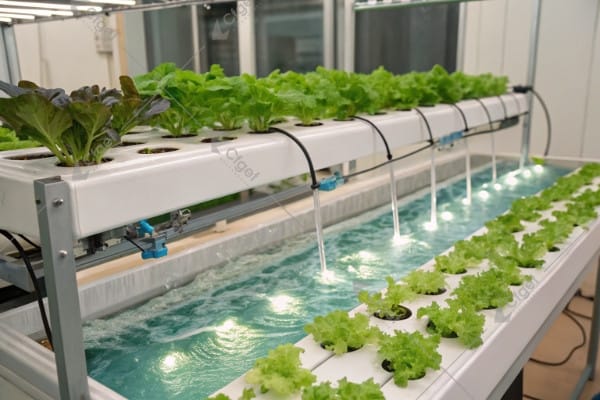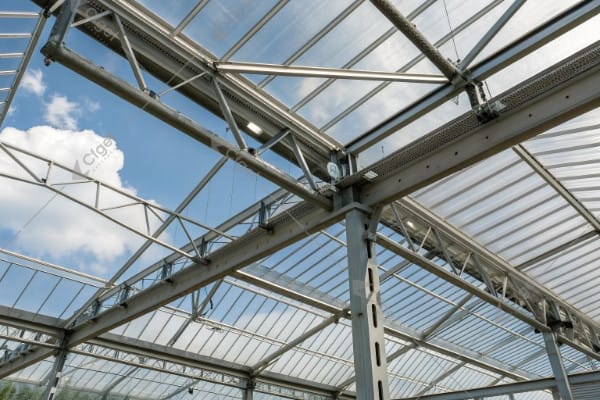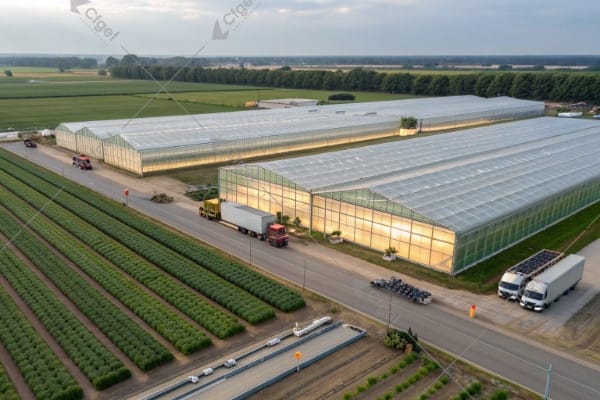Choosing greenhouse materials can be confusing. This confusion might lead to a less effective setup. But, understanding polycarbonate can help you make a smart choice for your growing needs.
Polycarbonate greenhouses are structures glazed with polycarbonate panels. This article explains what polycarbonate is, its main benefits, how it compares to other materials, and who typically uses these greenhouses, helping you decide if it’s right for you.
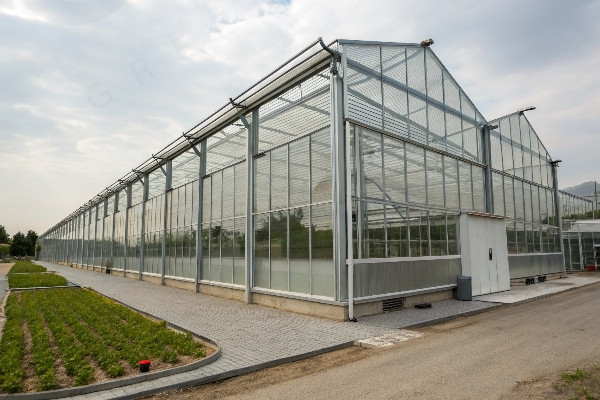
We have just touched on what polycarbonate greenhouses are. Now, it is time to look into the details. At CFGET, we have been working with various greenhouse materials for over 28 years. Polycarbonate has become a popular choice for many good reasons. I want to share my experience to help you understand this material better. Let us start by looking at what these panels are actually made of. This knowledge is the foundation for understanding their performance.
Don’t Miss:——Exploring Greenhouse Types: Finding the Perfect Structure for Your Needs
You might like:——Mastering Strawberry Greenhouse Cultivation: Best Practices for Optimal Growth?
What are Polycarbonate Greenhouses Made Of?
Many people hear "polycarbonate" but are unsure what it means for a greenhouse. This lack of clarity can make decisions harder. Knowing the material helps you appreciate its unique qualities.
Polycarbonate greenhouses are made using strong, thermoplastic polymer sheets. These sheets are lightweight yet very durable. They offer great impact resistance and good insulation, making them a practical glazing material.

Polycarbonate is a truly fascinating material for greenhouse construction. It is a type of thermoplastic. This means it can be heated, molded, and then cooled to form a solid, durable shape. Most commonly, for greenhouses, we see it in the form of twin-wall or multi-wall sheets. These sheets have internal chambers or flutes. These chambers trap air. This trapped air is key to polycarbonate’s excellent insulation properties. I have seen firsthand how this structure helps maintain stable temperatures inside the greenhouse. This is a big advantage, especially in regions with fluctuating weather. The material itself is incredibly strong. It can withstand significant impacts, much more so than glass. We often recommend polycarbonate for areas prone to hail or heavy snow. Its top pressure resistance is remarkable. This strength does not mean it is overly heavy. In fact, it is quite lightweight, which simplifies the construction process and reduces the need for very heavy support structures. Many polycarbonate sheets also come with a UV-protected layer on one side. This layer is crucial. It prevents the material from degrading quickly under sunlight and also protects the plants inside from harmful UV radiation.
Properties of Polycarbonate Sheets
To understand polycarbonate better, let’s look at its key properties in a table. This organization makes the information clear.
| Material Property | Description | Implication for Greenhouses |
|---|---|---|
| Chemical Composition | A group of thermoplastic polymers containing carbonate groups. | Provides inherent strength and flexibility. |
| Structure (e.g., Twin-Wall) | Sheets with two or more layers separated by internal ribs, creating air pockets. | Enhances insulation, light diffusion, and structural rigidity. |
| Impact Resistance | Extremely high, many times stronger than glass or acrylic. | Resists damage from hail, stones, and accidental impacts. |
| UV Protection | Often co-extruded with a UV-resistant layer on the sun-facing side. | Prevents panel yellowing, degradation, and protects plants. |
| Light Transmission | Initially high, diffuses light well, though can reduce slightly over time. | Provides good light for plants, reduces scorching, even spread. |
| Weight | Lightweight compared to glass. | Easier to handle, transport, and install; less structural load. |
| Thermal Insulation | Good, due to air pockets in multi-wall structures. | Helps maintain stable internal temperatures, reduces heating costs. |
This table shows different aspects of polycarbonate. It also shows why these are important for greenhouses. At CFGET, we select polycarbonate with these properties in mind to ensure quality for our clients.
The Main Benefits: Why Consider Polycarbonate Glazing?
You might wonder if polycarbonate is worth the investment for your greenhouse. Doubts can arise when comparing options. But, the unique advantages of polycarbonate often make it a superior choice.
Polycarbonate glazing offers excellent durability, safety, and insulation. It diffuses light effectively for better plant growth and provides UV protection, making it a very practical and beneficial option.
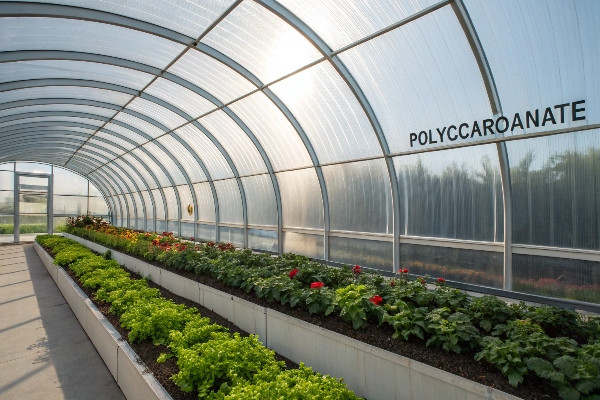
The benefits of using polycarbonate for greenhouse glazing are quite significant. I have seen many growers switch to polycarbonate and experience positive results. One of the biggest benefits is its incredible durability and impact resistance. As I mentioned, it can handle hail, falling branches, and even accidental bumps from equipment much better than glass. This means fewer worries about breakage and replacement costs. Safety is another key advantage. If polycarbonate does break under extreme force, it does not shatter into dangerous shards like glass. This is a huge plus for any environment, especially where children or pets might be around, or for public-access research facilities. Then there is the light diffusion. Polycarbonate sheets, especially the twin-wall types, scatter sunlight. This diffused light penetrates deeper into the plant canopy and reduces the risk of leaf burn or scorching. Plants tend to grow more evenly. Generally, we recommend polycarbonate greenhouses for areas with colder climates, areas with heavy precipitation, and areas with hail. It has extremely strong top pressure resistance and hail impact resistance. And it also has a very important characteristic, which is heat preservation. This material has extremely strong characteristics. It can reduce the heating system inside the greenhouse in cold areas, saving energy. This excellent insulation also means more stable temperatures, protecting plants from sudden drops or spikes. This makes it very suitable for growing vegetables and fruits that require consistent conditions.
Advantages of Polycarbonate in Detail
Let’s break down the main advantages. A table can illustrate these benefits clearly.
| Benefit | Explanation | Impact on Growers |
|---|---|---|
| Superior Durability | Highly resistant to impact, weathering, and breakage. | Longer lifespan, lower replacement costs, less worry about damage. |
| Enhanced Safety | Does not shatter into sharp pieces like glass. | Safer environment for people, animals, and plants. |
| Excellent Insulation | Traps air within its structure (e.g., twin-wall), providing good thermal R-value. | Reduced heating costs in winter, cooler in summer, stable plant environment. |
| Effective Light Diffusion | Scatters sunlight, providing even light distribution and reducing shadows. | Promotes healthier, more uniform plant growth; minimizes leaf scorch. |
| UV Protection | Blocks harmful UV radiation while allowing beneficial light spectrums. | Protects plants from UV damage; extends the life of the glazing material. |
| Lightweight Nature | Significantly lighter than glass. | Easier installation, less robust framing needed, potential cost savings on structure. |
| Design Flexibility | Can be cold-formed into arches and curved shapes to some extent. | Allows for more varied and aesthetically pleasing greenhouse designs. |
This table highlights why polycarbonate is a strong contender. At CFGET, we often guide clients toward polycarbonate when these benefits align with their specific needs and climate.
Key Differences Compared to Traditional Greenhouse Materials?
Choosing the right glazing involves comparing options. It can be hard to see the real differences. Understanding these distinctions helps you pick the best material for your specific situation.
Polycarbonate differs from glass in weight, safety, and insulation, and from film in durability and longevity. It offers a unique balance of strength, light diffusion, and thermal performance.
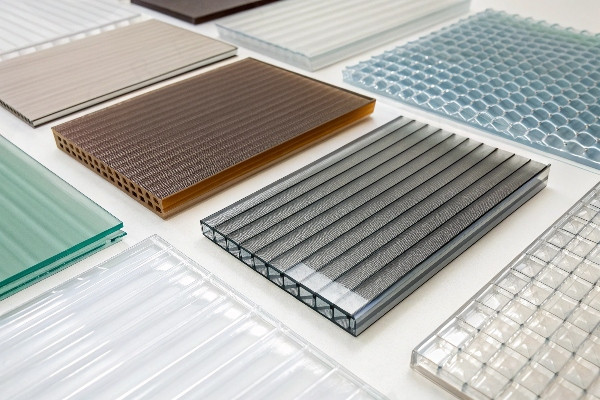
When we talk about traditional greenhouse materials1, glass and plastic films usually come to mind. Each has its place, but polycarbonate offers a distinct set of characteristics. Compared to glass, polycarbonate is much lighter. This makes it easier and often cheaper to install, as the supporting frame does not need to be as heavy-duty. Glass offers excellent light transmission when new and clean, often slightly higher than polycarbonate initially. However, glass is fragile. A stray stone or a hailstorm can lead to costly and dangerous breakages. Polycarbonate2, as we have discussed, is virtually unbreakable. Glass also provides less insulation unless you opt for expensive double or triple glazing. Plastic films, like polyethylene, are the cheapest option upfront. They are very lightweight and easy to install. However, films are not very durable. They can tear, get punctured, and degrade relatively quickly under UV light, often needing replacement every few years. Their insulation value3 is also generally lower than polycarbonate. This is where polycarbonate really shines, especially in specific areas. In cold areas, it has better insulation than both glass and film-covered greenhouses. This means significantly lower heating costs. One key difference, and a disadvantage of polycarbonate, is that its light transmittance will gradually decrease with the service life of the material. While high-quality polycarbonate with good UV protection lasts many years (often 10-20), this gradual reduction is something to consider, unlike glass which maintains clarity if kept clean.
Polycarbonate vs. Other Glazing Options
A comparative table can make these differences clearer. This helps in making an informed choice.
| Feature | Polycarbonate | Glass | Plastic Film (e.g., Polyethylene) |
|---|---|---|---|
| Durability | Very high, impact resistant | Moderate, prone to breakage | Low, tears easily, short lifespan |
| Weight | Lightweight | Heavy | Very lightweight |
| Safety | High, does not shatter | Low, shatters into sharp pieces | Moderate, no sharp pieces |
| Insulation (R-value) | Good to Excellent (especially multi-wall) | Poor (single pane) to Good (double/triple glazed) | Low to Moderate (double layer inflated) |
| Light Transmission | Good, diffuses light well, slight decrease over time | Excellent, direct light, maintains clarity | Good to Very Good initially, degrades |
| UV Protection | Typically built-in | Blocks some UV, can vary | UV stabilized versions available, degrades |
| Lifespan | Long (10-20+ years) | Very long (if not broken) | Short (1-5 years typically) |
| Initial Cost | Moderate to High | High | Low |
| Maintenance | Relatively low, cleaning | Cleaning, risk of breakage | Frequent replacement, cleaning |
This table summarizes the main trade-offs. At CFGET, we help clients weigh these factors based on their budget, climate, and growing objectives.
Who Typically Uses Polycarbonate Greenhouses and Why?
You might wonder if a polycarbonate greenhouse suits your specific needs. It is not always clear who benefits most. Knowing the typical users can help you see if it aligns with your goals.
Hobby gardeners, commercial growers, and research institutions often choose polycarbonate. They value its durability, safety, insulation, and the controlled growing environment it provides for various crops.

Over my nearly three decades at CFGET, I have seen a wide range of people and organizations opt for polycarbonate greenhouses. Hobby gardeners are a large group. They appreciate the safety aspect, especially if they have children or pets. The ease of assembly for many polycarbonate greenhouse kits is also a plus. They also benefit from the good insulation, which can extend their growing season without a huge heating bill. Commercial growers, particularly those in regions with challenging weather, are increasingly using polycarbonate. We generally recommend polycarbonate greenhouses for areas with colder climates, areas with heavy precipitation, and areas with hail. Its extremely strong top pressure resistance and hail impact resistance are major advantages. For these growers, the longevity and reduced risk of crop loss due to glazing damage are critical. The excellent heat preservation characteristic means lower operational costs in cooler regions, which is vital for profitability. This material can reduce the heating system needs inside the greenhouse, saving energy. In these greenhouses, it is generally used for the cultivation of vegetables and fruits, which often require stable environmental conditions. Research institutions also favor polycarbonate. They need reliable, controlled environments for their experiments. The durability and consistent light diffusion contribute to the quality of their research. For our clients in Central Asia, the durability under extreme climates is key. For those in parts of Europe or North America with cold winters, the insulation is paramount. Even in some Southeast Asian applications where storms can be an issue, the strength is valued.
User Profiles for Polycarbonate Greenhouses
Let’s look at typical users and their reasons in a table. This provides a structured overview.
| User Type | Primary Reasons for Choosing Polycarbonate | CFGET’s Experience & Support |
|---|---|---|
| Hobby Gardeners | Safety (no shattering), ease of assembly (kits), extended growing season due to good insulation, durability. | We offer various sizes suitable for home use and provide guidance on choosing the right thickness for their climate. |
| Commercial Vegetable Growers | Durability against weather, energy savings from insulation, good light diffusion for even crop growth. | CFGET designs large-scale polycarbonate greenhouses optimized for vegetable production, considering local climate needs. |
| Fruit Growers (e.g., berries) | Protection from pests and adverse weather, stable temperatures for sensitive fruit development, longevity. | We help fruit growers select appropriate polycarbonate types that balance light and insulation for optimal fruit quality. |
| Flower & Ornamental Nurseries | Consistent light, protection for delicate plants, ability to maintain specific temperature/humidity. | Our team assists nurseries in creating ideal environments with polycarbonate, sometimes combining it with other systems. |
| Research Institutions | Controlled environment, durability for long-term studies, safety, consistent light diffusion. | CFGET collaborates with researchers to provide custom polycarbonate structures meeting precise experimental requirements. |
| Schools & Educational Groups | Safety, durability, hands-on learning opportunities, visible plant growth. | We support educational projects with robust and safe polycarbonate greenhouse solutions. |
This table shows the diverse users of polycarbonate greenhouses. At CFGET, we tailor our recommendations based on the specific application and environmental conditions our clients face.
Conclusion
Polycarbonate greenhouses offer strength, safety, and good insulation. They are a smart choice for many growers looking for a reliable and efficient growing environment.
Understanding various greenhouse materials helps you choose the best option for your climate and growing goals, ensuring optimal plant health. ↩
Explore the advantages of polycarbonate for greenhouses, including durability and insulation, to make an informed choice for your gardening needs. ↩
Learn how insulation value impacts energy efficiency and plant growth in greenhouses, crucial for maximizing your gardening success. ↩

